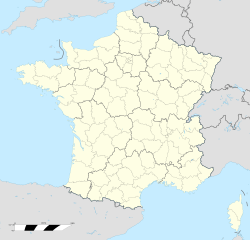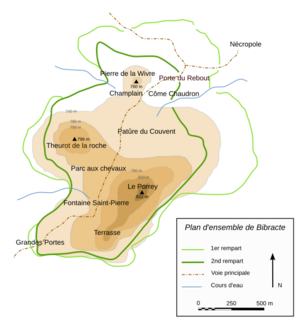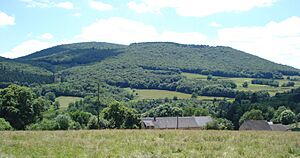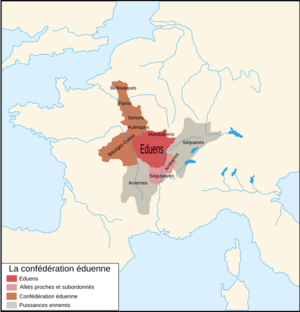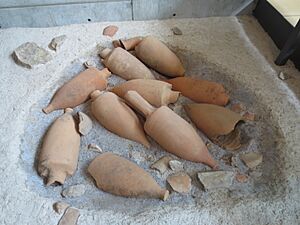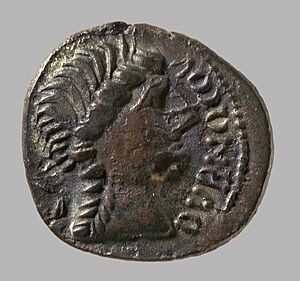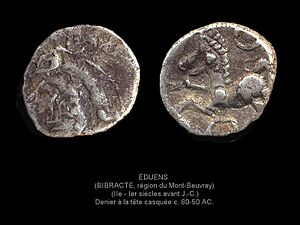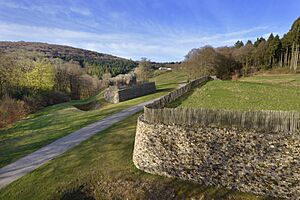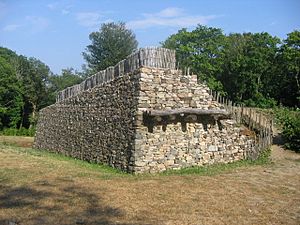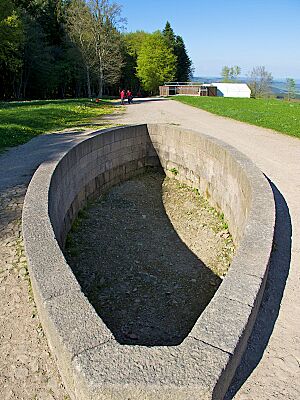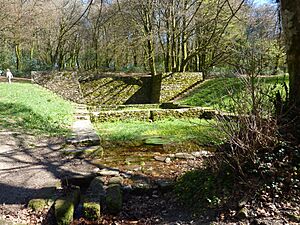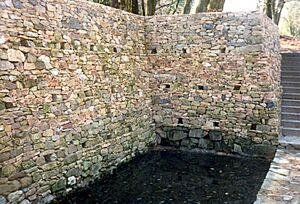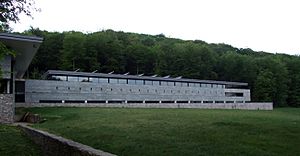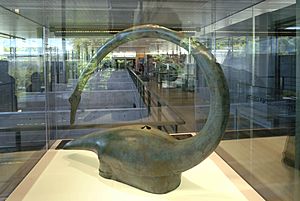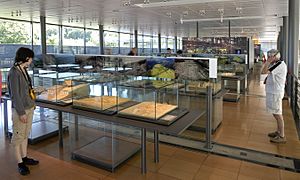Bibracte facts for kids
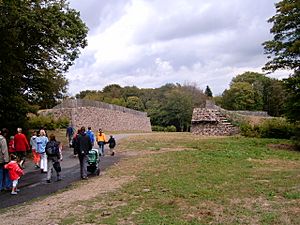
Walls of Bibracte
|
|
| Alternative name | Mont Beuvray |
|---|---|
| Location | Near Autun, France |
| Region | Gaul |
| Coordinates | 46°55′23″N 4°02′15″E / 46.92306°N 4.03750°E |
| Type | Oppidum |
| History | |
| Periods | Iron Age Europe |
| Cultures | Aedui |
Bibracte was an important ancient city in Gaul, a region that is now France. It was a type of fortified settlement called an oppidum. Bibracte served as the capital city for the Aedui people, one of the most powerful tribes in Gaul.
This ancient city was located near what is now Autun in the Burgundy region of France. The Aedui people lived during the Late Iron Age, and their culture is known as the La Tène culture.
Bibracte played a big role in history. In 58 BCE, the Roman general Julius Caesar defeated the Helvetii tribe in a battle not far from Bibracte. Later, in 52 BCE, a famous Gallic leader named Vercingetorix was chosen to lead all the Gallic tribes against the Romans right here in Bibracte.
After the Romans conquered Gaul, Bibracte was slowly abandoned. Its people moved to a new Roman city called Autun, about 25 kilometers away. Because it was left alone, Bibracte remained untouched until archaeologists rediscovered it much later.
Modern archaeologists started digging at the site in the late 1800s. Jacques-Gabriel Bulliot led the first excavations from 1867 to 1895. His nephew, Joseph Déchelette, continued this important work until 1907.
Today, the site is known as Mont Beuvray. It's a special archaeological park located in a protected forest. Many European countries work together here to study the past. It's also a place where young archaeologists learn their skills and where visitors can learn about ancient Gallic culture.
In 2007, Bibracte was recognized as a "Great Site of France" because of its historical importance. Before the Romans arrived, Bibracte was a large Celtic city with over 30,000 people. It was protected by a huge stone wall, called a Murus Gallicus, which surrounded an area of 135 hectares.
Contents
What's in a Name? The Meaning of Bibracte
The exact meaning of the name Bibracte is a bit of a mystery. Some experts think it comes from a Celtic word meaning "beaver." Others thought it might mean "twice fortified" in Latin, but this idea is less likely.
There were also old inscriptions found that mentioned a goddess named Bibracte. These inscriptions were found in Autun in the 1600s. This suggests the city might have been named after this goddess.
Finding Bibracte: A Journey Through Time
Bibracte is mentioned only twice in ancient Roman writings. Both times are in Julius Caesar's book, Commentaries on the Gallic War. He wrote about it in 58 BCE and again in 52 BCE.
For a long time, people wondered where Bibracte was located. Some thought it was at Autun, others at Beaune. But a third idea suggested it was on Mont Beuvray. This idea was supported by the similar names "Bibracte" and "Beuvray." Also, old stories and discoveries of pottery and coins on Mont Beuvray pointed to this location.
In the 1800s, Jacques Gabriel Bulliot became convinced that Mont Beuvray was the true site of Bibracte. He started digging there in 1867, with funding from Emperor Napoleon III. Bulliot's work proved that Bibracte was indeed on Mont Beuvray.
His nephew, Joseph Déchelette, continued the excavations until 1907. He compared Bibracte to other ancient cities across Europe. This helped show how connected the Celtic world was.
A Look at Bibracte's History
Archaeological finds show that people lived on Mont Beuvray as far back as the Neolithic Era. The city of Bibracte itself was founded around the end of the 3rd century BCE. It started with a large outer wall covering 200 hectares. Later, an inner wall was built, making the city a bit smaller.
The Aedui people were "friends of the Roman people," so they had good connections with Roman traders even before Caesar's conquest. In 58 BCE, Caesar's army won a battle nearby, but Bibracte itself was not harmed.
In 52 BCE, the Gallic tribes met in Bibracte and chose Vercingetorix as their supreme commander. Even after Caesar's victory at Alesia, he treated Bibracte kindly. He even stayed there for a winter, writing his famous book.
After the new Roman city of Autun was founded around 15 BCE, people gradually left Bibracte. They might have moved for economic reasons or to fit in with the Roman way of life. However, some traditions and religious practices continued at Bibracte for a while.
Bibracte's Power and Influence
Bibracte, as the capital of the Aedui, was a very powerful city. The Aedui had many alliances with other tribes. They also fought wars with rivals like the Arverni and Sequani to control large parts of Gaul. Rome was allied with the Aedui for a long time, calling them "our blood brothers."
The Aedui were part of a large group of Celtic tribes. This group included the Parisii (who lived where Paris is today) and the Bituriges. Their influence spread across much of Gaul.
Trade and Commerce
Bibracte was located at an important crossroads for trade. Roman goods traveled up the Rhône river and then through Aedui territory to reach other parts of Gaul. This allowed Roman products, like wine in amphoras, to spread throughout the Celtic world.
The Aedui also had a system of customs, taxing goods that passed through their land. This helped them become very wealthy. They even fought with the Sequani tribe to control the Saône river, which was key for taxing trade.
Archaeologists have found many cellars and public buildings in Bibracte. These places stored large amounts of grain and wine imported from southern countries. This shows how important trade was to the city.
How Bibracte Was Governed
The Aedui had a complex political system. A senate, made up of one member from each important family, made decisions. The top leader was called the vergobret. This person was like a supreme judge and administrator, serving for one year. The vergobret could not leave the Aedui territory during their term, which prevented them from leading the army outside the borders. This rule, along with others, helped prevent any one person or family from becoming too powerful.
The druids also held important positions. They were not just religious leaders; some, like Diviciacus, even held high military roles. Druids were also involved in electing the vergobret.
Exploring Bibracte: Archaeological Discoveries
Archaeological work at Bibracte stopped for many years after Joseph Déchelette. But in 1984, excavations started again, thanks to French President François Mitterrand. Bibracte was declared a site of national importance, which helped fund new research.
Since then, the European Archaeological Center of Mont Beuvray was created. It includes the site, a museum, and a research center. Every summer, experts, professors, and students from all over Europe come to Bibracte to dig and study. They come from universities in Austria, Germany, France, and many other countries.
Finding Clues: Archaeological Techniques
Early archaeologists like Bulliot used simple methods. They looked for bumps and changes in the landscape to map out the ancient city. Today, archaeologists use more advanced tools like theodolites and GPS.
New technologies like LIDAR (using airborne laser scanners) are also being used. LIDAR can create detailed maps of the city very quickly, even through dense forest. This helps researchers understand the layout of Bibracte without having to dig everywhere.
How Bibracte Was Organized
Early research showed that Bibracte was organized into different neighborhoods. A main road ran through the city, from the Rebout Gate to the Great Gates. The city's layout was shaped by the hilly terrain, which included three main summits.
Modern excavations have largely confirmed these ideas, adding more details to our understanding.
City Walls and Gates
Bibracte was protected by strong walls built in the Murus Gallicus style. This type of wall used wood, earth, and stone. The city actually had two main sets of walls. The inner wall was built after the outer wall, meaning the city's protected area became smaller over time, from 200 to 135 hectares.
The inner wall was about 5 kilometers long. Building it required a huge amount of wood, earth, and iron. The outer wall was even larger and was later taken apart to build the inner one.
The walls had about 15 gates. The most famous is the Rebout Gate, which was 20 meters wide and 40 meters deep. Archaeologists have found evidence of five different times the gate was rebuilt. They even found traces of a palisade from the Neolithic Era underneath it. A reconstruction of the Rebout Gate now stands at the entrance to the ancient city.
Public Buildings and Gathering Places
Recent excavations have uncovered the remains of a large public building from around 70 BCE. It was a square wooden building with galleries around a central courtyard. Later, it was replaced by a monumental stone platform. The exact purpose of these buildings is still a mystery, but they were likely important public spaces or temples.
Artisan Workshops
Near the Rebout Gate, archaeologists found neighborhoods where artisans lived and worked. These areas, called Côme Cauldron and Champlain, were centers for metalworking. Blacksmiths, bronzeworkers, and enamellers had their workshops here. It's also thought that goldsmiths and coin makers worked in Bibracte.
Mines for gold, iron, and tin ore have been found nearby. It seems that metals were brought to Bibracte in bars, then crafted into goods in these specialized workshops.
Homes in Bibracte
Most Gallic houses were made of wood and earth, so not many traces remain. Stone was mostly used for the city walls. However, in the Horse Park district, some stone houses have been found. These were likely homes for important families and were built after the Gallic Wars.
The Horse Park District
The Horse Park plateau in the center of Mont Beuvray has several Roman-style stone houses. One house, called PC1, was very large, covering about 3,500 square meters. It had an atrium (an open central court), porticos, and even thermae (baths) with a heating system.
Archaeologists believe there were about 15 such large homes in this area. It's thought to have been a neighborhood for the city's elite, though some workshops were also found nearby.
The Monumental Basin
In the center of the main road, there is a large pink granite basin. This basin is thought to have had a sacred purpose, perhaps as a water shrine or a special place for the city's founding. Its design has special astronomical and mathematical meanings.
For example, the basin's short side lines up with the winter solstice sunrise and summer solstice sunset. Its shape also uses a precise 3:4:5 Pythagorean triangle. Some experts believe this basin was a druidic monument. Ancient writers said that druids were philosophers who knew a lot about astronomy and mathematics.
Some scholars suggest the basin's main axis points to the constellation of Gemini. This might relate to the importance of "Divine Twins" in Gallic religion. The basin's boat-like shape could also connect to myths about a solar boat.
It has been suggested that Bibracte might have been the site of a druidic school. Julius Caesar wrote that druids studied for many years, learning about stars, the universe, nature, and the gods. They believed that souls do not die, which made them brave in battle.
Places of Worship
Bibracte had about ten springs and five fountains. The Saint Pierre Fountain was a sacred place where people left coins and votive offerings. At the top of the mountain, a large Celtic worship area, called a nemeton, was found. Underneath a 19th-century chapel, archaeologists discovered a Gallo-Roman temple.
Ancient Burial Grounds
A burial ground, or necropolis, was found near the modern museum. It contained 70 burial enclosures where people were cremated. Other burial urns were found near the Rebout Gate, possibly belonging to an important family.
The Basilica: A Roman Touch
Archaeologists found the remains of a Roman basilica under a large house in the Convent Pasture area. This was a unique public building for Gaul at the time, with three main sections and many columns. It shows that the Aedui adopted Roman architecture and culture very quickly. This basilica is the oldest example of Roman stone architecture found in non-Mediterranean Europe.
Bibracte: A Window to the Celtic World
Museum of Celtic Civilization
The site is home to the Museum of Celtic Civilization, which opened in 1996. The museum's design reflects the different ages of human history, using carved stone, polished stone, and metal. One side of the museum has large windows that offer views of the ancient site.
The museum has many interesting exhibits. It tells the story of Bibracte's discovery and its place in European Celtic culture. You can learn about war, ancient cities, trade, and farming. There are also displays about the daily life of the Aedui, showing jewelry, pottery, and tools.
The museum also hosts special temporary exhibits each summer. These exhibits explore different aspects of the Celtic world, such as:
- Celtic Europe
- The Gallic druids
- Blacksmiths and metal merchants
- The treasures of women
Research Center
About four kilometers from Mont Beuvray, in the village of Glux-en-Glenne, is a major research center for the Celtic world. It has one of the most important libraries on the subject. This center also stores archaeological finds and provides facilities for archaeologists, students, and researchers from across Europe who work at Bibracte.
Images for kids
See Also
- Battle of Bibracte
- Oppidum
- Gergovia
- Alesia
- Oppidum of Manching


